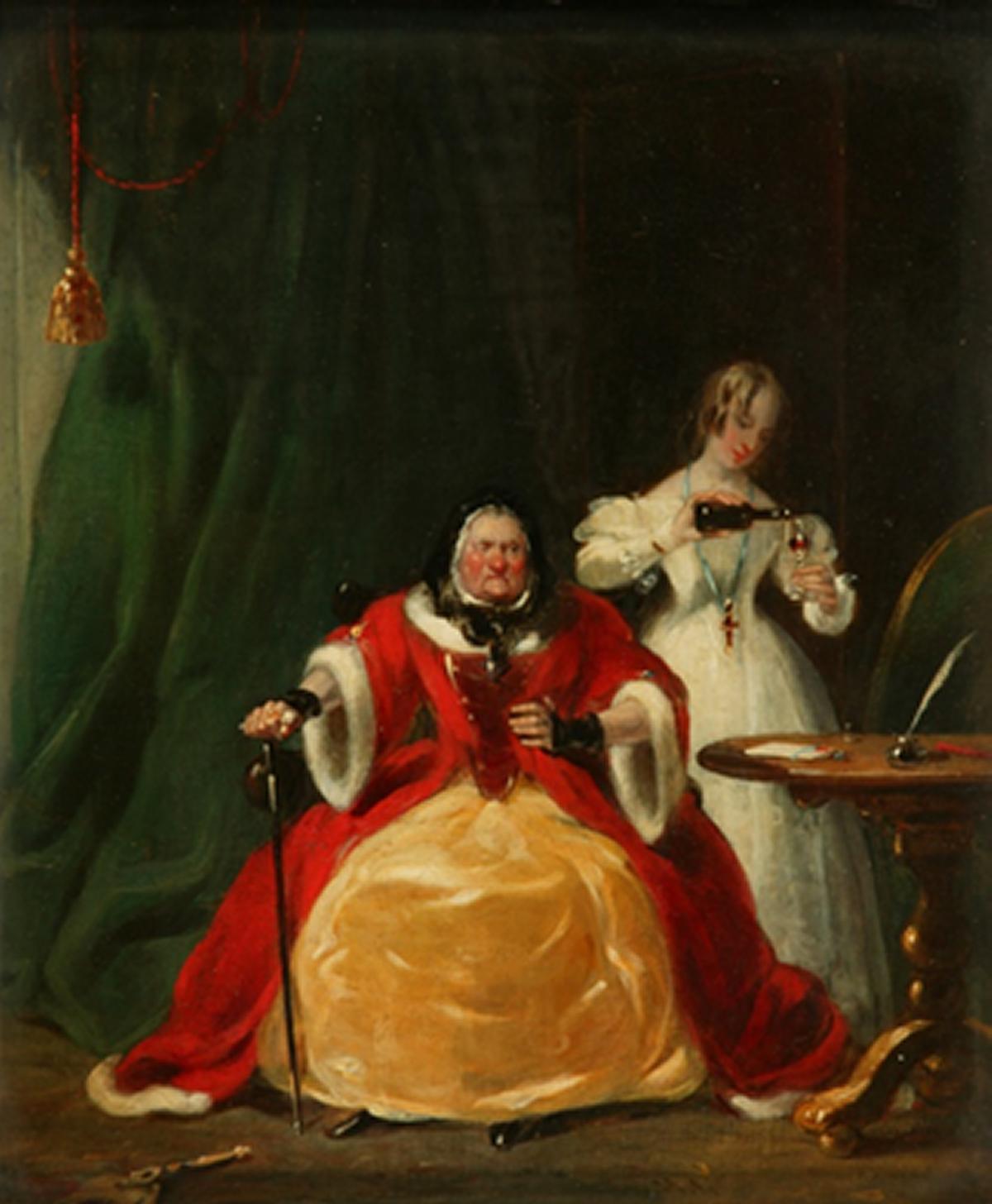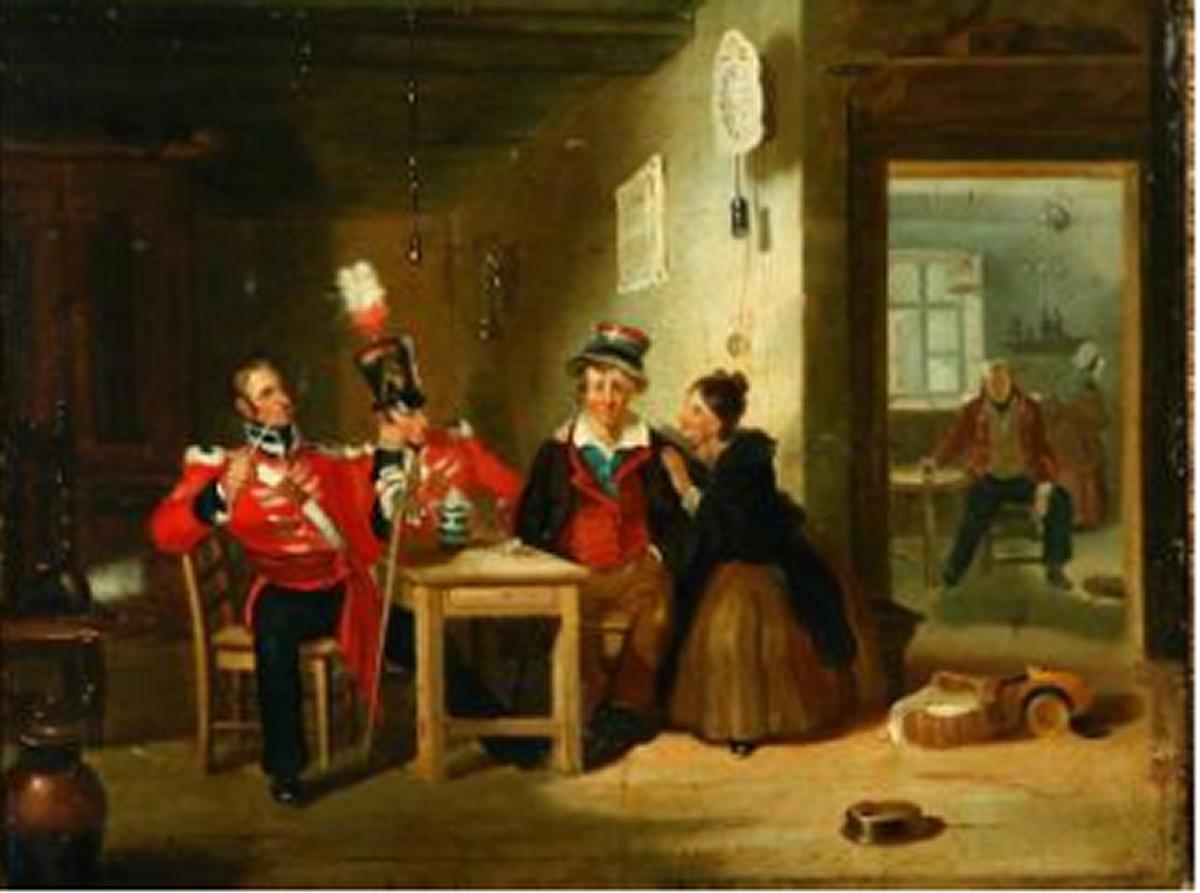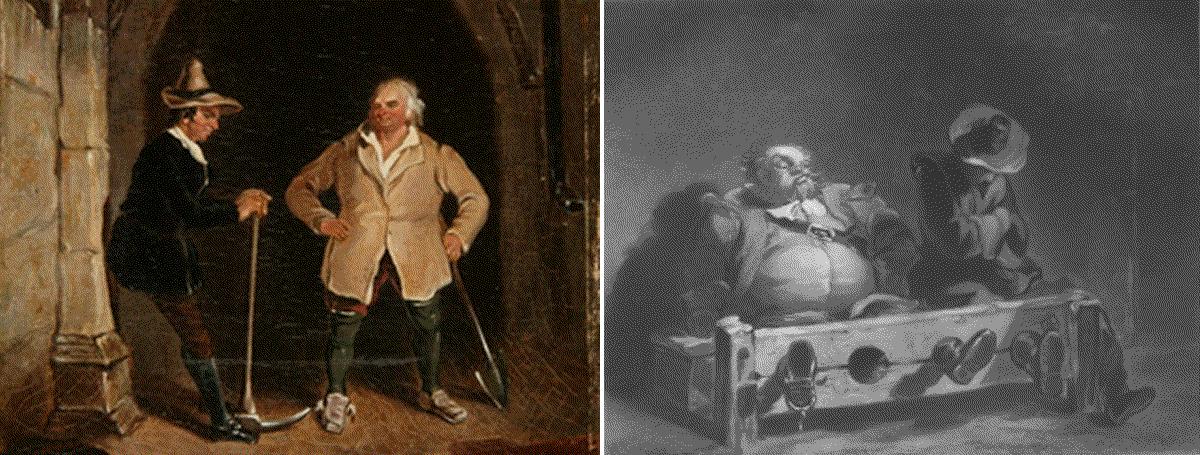The Ancoats Artist (2)
A Flourishing Career
When we left Henry Liverseege in 1827, he had established himself locally in Manchester as a portrait painter, but found this work tiresome and unrewarding. He turned to "dramatic" painting and his first three exhibited works were quite well received, confirming his decision to concentrate on this kind of work. Opportunities to develop his skills were not really available in Manchester, so he decided to spend some time in London to see a wider variety of original work and obtain some decent training. But before we look at his time in London, let's take a quick look at the man.
What was Henry Liverseege like?
Physically, Henry would today be regarded as short at 5' 5" tall but in his time, would not have stood out against his contemporaries, whose average height would have been just 5' 7". His build would have been noticeably slight, given suggestions that as an adult he weighed only 75 lbs, and his left shoulder somewhat higher than the right. His portraits show a finely featured face with a high forehead (perhaps the early signs of male pattern baldness) and quite long hair. He was clean-shaven. His voice was somewhat high pitched but was described by those who had met him as pleasant. He is recorded as dressing well, with perhaps a measure of vanity.
In temperament he could be sensitive and easily irritated by any perceived slight or impropriety. Doubtless his physical afflictions contributed to his occasional 'tetchiness'; he seems, though, to have been similarly quick to forgive. He was gregarious and enjoyed good company and conversation. While in London, he maintained a room specifically for entertaining friends and other visitors. He appears to have made friends easily and to have maintained many long-term friendships. These included George Richardson, the poets John Bolton Rogerson and Maria Jane Jewsbury, the painters Michael Pease Calvert and the engravers/printsellers Samuel Grundy and Charles Swain.
Visiting London
For Henry Liverseege, who had, so far as is known, never travelled outside Manchester, the thought of spending time in London must have been both a daunting and an exciting prospect. In 1828 it was not the simple matter of jumping on a train as it would become just ten years later when the first through service (via Birmingham) would open, but a lengthy stagecoach ride over poorly-surfaced roads. At this time it could take up to 24 hours to get to London, a gruelling journey for the physically fit, but possibly a very demanding one for someone with Henry's rather delicate constitution. Possibly he used one of the services which offered an overnight stop at Birmingham.
Henry is recorded as making three visits to the capital between 1828 and 1831 but while some of his activities and encounters can be identified with a specific visit, many cannot be dated precisely, so much of what follows cannot be pinned down to any particular visit. The first visit appears to have commenced in 1828 but was cur short by the death of his mother in April of 1829. He returned to London later in 1829 and remained there for 21 months, returning in what must have been late 1830. His final visit was during the first half of 1831 and he returned to Manchester in July of that year, after being delayed for some time by an invitation to meet with the Duke of Devonshire. It was time well invested as the Duke later purchased his painting of "Sir Piercie Shafton and Mysie Happer" for fifty Guineas, a painting still in the Devonshire collection.
Formal Training
One of Henry's first pleasures would have been to visit the National Gallery, where he could see a much wider variety of paintings than were open to him in Manchester. He spent much time in the gallery both sketching from and copying from the works on display, in particular from Rubens, Vandyke and Teniers, the latter of which greatly influenced his choice of subjects for some of his future paintings. He also enrolled with a private art academy in Savoy Street on the Strand where he received some instruction.
While in London he had the opportunity to see a number of private art collections. Among these was the collection of Sir Thomas Lawrence, then living at what would be his final home, 65 Russell Square, and which he opened freely to other artists. While viewing Lawrence's collection, Henry was fortunate enough to meet Sir Thomas and was invited to discuss his work and artistic aspirations with the then President of the Royal Academy. Sir Thomas was clearly impressed with henry and offered that if he wished to apply to study at the Royal Academy, he would provide him with the necessary letter of recommendation. Henry took up Sir Thomas's offer and applied for admission to the Royal Academy school, but owing to some misunderstanding, the nature of which differs between the posthumous accounts of his life, his application was rejected. He never applied again, though did exhibit pictures at the R.A. exhibition in 1831 so clearly bore no lasting ill-feelings. It is unclear how much work he completed during this time.
This first trip to London seems to have lasted around six months, somewhat shorter than he had intended but curtailed by his mother's death. The visit was overshadowed by his failure to get into the Royal Academy School, so perhaps he viewed it as something less than a success, but, it did not stop him returning soon after the funeral for a second and greatly extended stay.
Literary Subjects
Henry was working throughout his stay in London (nothing is known of where he lodged or what studio facilities this might have offered). He settled on producing works inspired by characters and scenes in the works of his favourite authors: Shakespeare, Sir Walter Scott, Miguel de Cervantes and Samuel Butler. These subjects were fashionable at this time and Henry possibly saw them as having commercial potential.
From Shakespeare, he painted the death scene from Romeo and Juliet, Touchstone and Audrey (from As You Like It) and Hamlet and the Ghost. From Cervantes, of course, he depicted Don Quixote. From Butler he made a number of studies of Hudibras and Ralpho, but it was Scott who provided the substantial majority of his subjects. These included Adam Woodcock, the falconer, Edie Ochiltree, Sir Piercie Shafton and Mysie Happer and Meg Merrilees.
Genre Paintings
Alongside literary characters and scenes, Henry painted "genre" scenes, scenes drawn from contemporary life. In this he was possibly influenced by the work of David Teniers. His subjects were widely varied and often included an element of humour or whimsy. For example "A touch of the Spasms" and "The Recruit"
A Touch of the Spasms

Here he depicts a scene in which a rather irascible looking elderly lady is being attended by a young woman, perhaps her daughter or grand-daughter. The young woman is pouring the old lady a glass of medecine for the old lady's "spasms". The old lady's flushed cheeks and red nose hint strongly that the "medecine" is probably brandy or some other arduous spirit and that the old lady's spasms are a regular occurrence.
The Recruit

The last of his genre works, and possibly his master-work, completed before his untimely death, depicts the interior of an inn. Three men sit at a small table sharing a drink. Two of these are soldiers, both smart and self-assured, while the third is a bumpkin who they have plied with drink and tales of derring-do in order to persuade him to enlist as a soldier. The bumpkin is clearly "three sheets to the wind" and incapable of making any informed decision. To the right of this trio is a young woman pulling on the bumpkin's arm and apparemtly trying to get him to come away with her - perhaps she is his girlfriend or even his wife. She seems to be having little success. Perhaps he has already "taken the king's shilling". This group of figures tells a story in itself, but another story is shown in the background. Through an open door we can see an elderly man wearing what looks like a red soldier's jacket, and an elderly lady. On closer examination, the old man has a wooden leg. This can be read as a prediction of what lies ahead for the bumpkin once the army has no further use for him. It is said that the model for the sergeant (left hand soldier) was the artist's father. This painting is said to have sold for £130, the highest price Henry had received for any of his works.
Working with Models
Henry's compositions were invariably created using models for the characters and props for the static elements. The identities of many of his models have been well recorded. One of his favourite models for the more "rotund" male figures was Thomas Shepheard. We know little about Shepheard other than that he lived "...at the upper end of Bradford Street". Shepheard posed for "The Falconer", "Edie Ochiltree", "The Ghost Story" (as the central figure; the darkly clad figure was a Mr. Nimmo, a basket maker who lived in Spear Street), "The Gravediggers" (the second gravedigger being Will Yeomans, an old friend who also posed for other paintings) and several others. For Falstaff, in "Falstaff and Bardolph", he engaged Alexander McMinn, a blacksmith who attracted the nickname of the "fat farrier", whose smithy was in Back Mosley Street.

The Gravediggers (Detail), Left; Hudibras and Ralpho, Right
For "Catherine Seyton", his sister Mary sat as his model. Mary married Alfred Gomersal Vickers, a fellow artist, in 1833. It appears that Henry met Vickers on one of his visits to London. When he and Mary met is not rcorded but it is possible it was at Henry's funeral, which he is known to have attended. The marriage was cut short by Vickers' untimely death in 1837. Vickers owned a painting by Henry called "Agnes" for which the sitter would appear to have been Vickers' sister Agnes Vickers.
Where necessary, Henry would resort to making clay models, in particular when making his drawing of "Hudibras and Ralpho in the Stocks" as well as making clay models to represent the protagonists, he had a model pair of stocks made so that he could create the entire composition in miniature.
Meetings with William Etty and other Artists
Henry, always sociable, made the acquaintance of other artists. Among these was William Etty, who Henry visited on at least three occasions. The third of his visits was the source of some offence to Henry, who ever a stickler for observation of the social conventions was offended that Etty continued to work while he waited, seemingly ignored. He finally left, pointing out to Etty that this was his third "call" against Etty's one call on Henry. Etty subsequently called on Henry and the perceived slight was soon forgotten. How Henry viewed Etty's work is not recorded; the dominance of (some might say gratuitous) naked female flesh would, perhaps, have been rather shocking to Henry, who had been brought up in the more staid provinces.
Henry was also familiar with Edwin Landseer and the great painter of wildlife contributed to Henry's painting of "Little Red Riding Hood" by (appropriately) painting the wolf encountering the heroine in the woods. Landseer is said to have greatly admired the painting.
The (un)Drunken Cobbler
There is one anecdote which appears in all biographies of Liverseege and it is worth repeating here. Henry wished to paint Christopher Sly and the Landlady (from The Taming of the Shrew). The scene from the beginning of the play shows the drunken Sly being ejected by the landlady of an inn. Henry found his model in a cobbler, who looked the part, but wishing the depiction to be true to the character provided his model with a bottle of gin, which he dispatched without the slightest sign of inebriation. Henry procured a second bottle which disappeared like the first with no more effect. Henry's patience snapped. "Begone!" he shouted "It will cost me more to get you drunk than the picture will make!"
Exhibiting his Work
We have seen already that his exhibition debut was at the first exhibition of the (later to be Royal) Manchester Instirution in 1827. He continued to show his paintings with the following being some of the occasions:
- 1829 Royal Manchester Institution - Adam Woodcock; Storm Scene from The Antiquary; Portrait of Mrs. Calvert; Musidora; Portrait of Dr. Jarrold
- 1830 Royal Manchester Institution - Captain Macheath
- 1830 Society of British Artists - The Inquiry
- 1831 Society of British Artists - The Gravediggers; Catherine Seyton; The Benediction
- 1831 Royal Academy - Hamlet and his Mother in the Closet Scene; Sir Peircie Shafton and Mysie Happer
- 1831 Royal Manchester Institution - Don Quixote in his Study; Good Resolution; Captain Macheath in Prison; The Weekly Register (Cobbett's Register)
- 1832 Royal Manchester institution - Meg Merrilees and Hazelwood
- 1832 British Institution - A Spanish Gentleman (Don Quixote?); The Recruit
Multiple Copies
Towards the end of Henry's time in London, his paintings were selling well. Perhaps better than the obituaries record. As I have searched for Henry's works, of which to date I have located some 220, it becomes clear that several of his subjects exist in multiple copies. These do not appear to be "versions" since there is no material difference between them. It would seem that having produced a well-received painting, he would produce one or more copies which he presumably sold, perhaps at a discount, after the original work had been sold. There are, for example, two copies of "Sir Peircie Shafton and Mysie Happer", one in the Duke of Devonshire's collection and one in Manchester Art Gallery. Similarly there are copies of "Adam Woodcock" (AKA "The Falconer") in both the Whitworth (since 1905) and in private hands (2008). Of his most accomplished painting, "The Recruit", there are possibly as many as eight copies.
It is known that Henry's paintings were copied by others after his death and so the possibility that some of these copies were not by his hand. It is not helpful that he did not always sign his work and so separating any copies by others from those by Henry is not easy. Some copies, however, have provenance which makes their production by Henry himself beyond dispute.
Next Chapter
Henry returns to Manchester and his health declines leading to his early death. His burial and obituaries. A memorial is erected 30 years after his death. He slips into obscurity but his work lives on. READ THE FINAL BLOG...
- Hits: 199